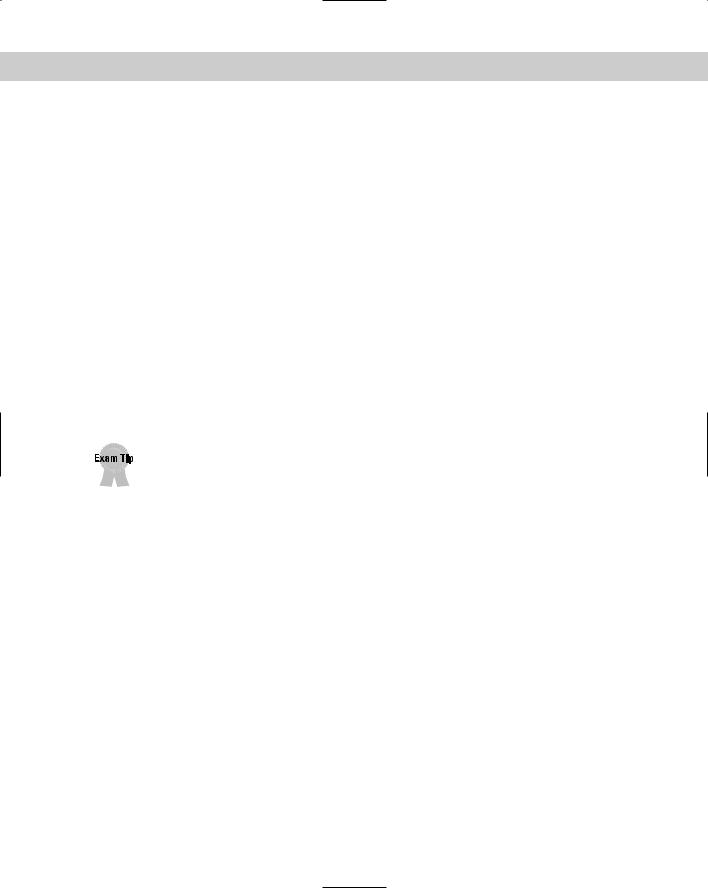
- •About the Author
- •Credits
- •How This Book Is Organized
- •Part I: Linux Basics
- •Part II: Installation
- •Part III: Configuration
- •Part IV: Administration
- •Part V: Maintaining the Linux System
- •How Each Chapter Is Structured
- •How to Use This Book
- •Conventions Used in This Book
- •What is Linux?
- •The origin of UNIX
- •Who started Linux?
- •Understanding Open Source
- •Understanding Closed Source
- •Understanding Artistic License
- •Is Freeware really free?
- •Is Shareware never free?
- •A comparison and contrast of licensing methods
- •The Growth of Linux
- •Linux on a Personal Computer
- •Graphical installation
- •Hardware detection
- •Graphical user interface
- •Linux limitations on the PC
- •Linux succeeds on the PC
- •Linux on workstations
- •Linux on servers
- •Summary
- •Assessment Questions
- •Scenarios
- •Answers to Chapter Questions
- •Assessment Questions
- •Scenarios
- •Linux Kernel
- •Kernel versions
- •Kernel availability
- •Linux Distributions
- •Beehive
- •BlueCat
- •Caldera OpenLinux
- •Debian
- •Corel
- •DragonLinux
- •Elfstone
- •Gentoo
- •Hard Hat Linux
- •KRUD
- •LinuxPPC
- •Mandrake
- •Phat Linux
- •Slackware
- •StormLinux
- •SuSE
- •TurboLinux
- •Yellow Dog Linux
- •Mini and Specialty Distributions
- •Astaro
- •KYZO
- •FlightLinux
- •NetMAX
- •Packages and Packaging Solutions
- •Red Hat Package Manager
- •Debian Package Management System
- •Tarball
- •Linux Resources
- •Summary
- •Assessment Questions
- •Scenarios
- •Lab Exercises
- •Answers to Chapter Questions
- •Assessment Questions
- •Scenarios
- •Linux In the Real World
- •Word Processing
- •Spreadsheets and databases
- •Web browsing
- •File transfer
- •More, more, and more applications
- •The Server and DNS
- •A Linux Web server
- •Linux e-mail server
- •File servers
- •Proxy, news, and search servers
- •FTP servers
- •Firewalls
- •Determining Linux Roles and Services
- •Comparing Linux with other operating systems
- •Hardware compatibility
- •Summary
- •Assessment Questions
- •Scenarios
- •Answers to Chapter Questions
- •Assessment Questions
- •Scenarios
- •Installing Linux
- •Final Preparations for Installation
- •Verification
- •Package selection
- •Final hardware verification
- •Pre-installation partitioning planning
- •Installing Linux
- •Text or GUI installation
- •Basic setup of Linux
- •Selecting the machine type
- •Partitioning the hard disk drive
- •Installing a boot manager
- •Creating the Boot Diskette
- •Networking
- •Additional installation information
- •Accounts and passwords
- •Additional packages to install
- •GUI installation
- •Obtaining video card information
- •Configuring the X windows system
- •Selecting the windows manager or desktop environment
- •Summary
- •Assessment Questions
- •Scenarios
- •Lab Exercises
- •Answers to Chapter Questions
- •Chapter Pre-test
- •Answers to Assessment Questions
- •Scenarios
- •Alternative to the GUI Installation
- •Command Line installation
- •Install the Linux system
- •Network installations of Linux
- •Review of a Linux Installation
- •Installation media
- •Initial selections
- •Installation type or class
- •Disk partitioning and formatting
- •Installing LILO
- •Network configuration
- •User accounts
- •Authentication methods
- •Package selection and installation
- •A Dual-Boot Installation of Linux
- •Linux with Microsoft Windows
- •Linux with Microsoft Windows NT and 2000
- •Linux and Solaris
- •Linux and other operating systems
- •Installing Additional Software with gzip and tar
- •Installing Additional Software with RPM
- •Removing software with RPM
- •Upgrading software with RPM
- •Query the RPM software
- •Verify the RPM software
- •Verify the package files
- •Upgrading the Kernel
- •Upgrading a Linux Kernel
- •System Log Files
- •The Final Test of the Installation
- •Summary
- •Assessment Questions
- •Scenarios
- •Lab Exercises
- •Answers to Chapter Questions
- •Chapter Pre-test
- •Assessment Questions
- •Scenarios
- •What is the X Window System?
- •The X Window System
- •X Client and Server communications
- •X Window Manager
- •Configuring X Window Systems
- •Custom X Window System Programs
- •Manual Configuration of the X Window System
- •Documentation
- •Summary
- •Assessment Questions
- •Scenarios
- •Lab Exercises
- •Answers to Chapter Questions
- •Chapter Pre-test
- •Assessment Questions
- •Scenarios
- •Basic Network Services
- •TCP/IP Protocol Suite
- •Connection protocols needed
- •Other network protocols
- •Configuring Basic Network Services
- •Host name
- •IP addressing
- •DHCP
- •Netmask
- •Hardware resources
- •Routing and gateways
- •PPP, SLIP and PLIP connections
- •Server Tasks with
- •IP aliases for virtual hosts
- •Apache Web Server
- •Samba File Server
- •Home directories
- •Disk shares
- •Configuring Client Services
- •SMB/CIFS
- •NIS client configuration
- •NFS client configuration
- •Configuring Internet Services
- •Web browser
- •POP and SMTP
- •TFTP
- •SNMP
- •Remote Access
- •Rlogin
- •Telnet
- •OpenSSH
- •Documentation
- •Summary
- •Assessment Questions
- •Scenarios
- •Lab Exercises
- •Answers to Chapter Questions
- •Chapter Pre-test
- •Assessment Questions
- •Scenarios
- •Adding Hardware
- •Memory
- •Swap
- •Adding a hard drive
- •Video and monitor
- •Printers
- •Configuration files
- •Setting environment variables
- •BASH
- •Documentation
- •Summary
- •Assessment Questions
- •Scenarios
- •Lab Exercises
- •Answers to Chapter Questions
- •Chapter Pre-test
- •Assessment Questions
- •Scenarios
- •Basic User and Group Administration
- •What are users and groups?
- •Creating users
- •Change user information
- •Deleting users
- •Creating groups
- •Getting Around Linux
- •Navigating Linux
- •Common file and directory commands
- •Setting File and Directory Permissions
- •Mounting and Managing File Systems
- •Mount
- •Umount
- •Mounted file systems
- •Summary
- •Assessment Questions
- •Scenarios
- •Lab Exercises
- •Answers to Chapter Questions
- •Chapter Pre-test
- •Assessment Questions
- •Scenarios
- •Multi-User Environment
- •The creation of Virtual Consoles
- •The Linux Terminal Server Project
- •Configurations for remote systems
- •Monitoring remote connections
- •Common Shell Commands
- •Basic shell scripts
- •Caution using root access
- •Navigating the GUI interface
- •Summary
- •Assessment Questions
- •Scenarios
- •Lab Exercises
- •Answers to Chapter Questions
- •Chapter Pre-test
- •Assessment Questions
- •Scenarios
- •Linux Runlevels
- •init
- •Shutting down Linux
- •Managing Linux Services
- •Configuring Linux Printing
- •lpd daemon
- •/etc/printcap
- •Printing management
- •Using the vi Editor
- •vi operation modes
- •Editing text files
- •Using the
- •Summary
- •Assessment Questions
- •Scenarios
- •Lab Exercises
- •Answers to Chapter Questions
- •Chapter Pre-test
- •Assessment Questions
- •Scenarios
- •Disk and File System Management
- •Repairing Partitions
- •System Automation and Scheduling
- •cron
- •Core Dumps
- •Analyzing core dumps
- •GNU Debugger
- •Managing Networking Interfaces
- •Installing System Packages and Patches
- •Compressed archive
- •Debian Package Installer
- •Slackware Package Installation
- •Summary
- •Assessment Questions
- •Scenarios
- •Lab Exercises
- •Answers to Chapter Questions
- •Chapter Pre-test
- •Assessment Questions
- •Scenarios
- •Linux Processes
- •Core services versus non-critical services
- •Process administration
- •Process control
- •Monitoring Log Files
- •Maintaining Documentation
- •Summary
- •Assessment Questions
- •Scenarios
- •Lab Exercises
- •Answers to Chapter Questions
- •Chapter Pre-test
- •Assessment Questions
- •Scenarios
- •Linux Security
- •Securing the Environment
- •Location
- •Environment
- •System Security
- •System/user files
- •Permissions
- •Log auditing
- •Backups
- •Linux Security Best Practices
- •Network security
- •Firewall
- •System security
- •Securing a Web server
- •Securing an FTP server
- •FTP program version
- •FTP configuration files
- •Process security
- •Summary
- •Assessment Questions
- •Scenarios
- •Lab Exercises
- •Answers to Chapter Questions
- •Chapter Pre-test
- •Assessment Questions
- •Scenarios
- •Disaster Recovery Planning
- •Types of data
- •Frequency and Scheduling
- •Storage and media types
- •Recovering data
- •Offsite storage
- •Linux Backup Tools and Commands
- •Third party tools
- •Tape devices
- •Summary
- •Assessment Questions
- •Scenarios
- •Lab Exercises
- •Answers to Chapter Questions
- •Chapter Pre-test
- •Assessment Questions
- •Scenarios
- •Identifying the Problem
- •Methodology and Best Practices
- •Troubleshooting Resources
- •Documentation resources
- •Internet resources
- •System Log Files
- •Tools for Log Files
- •Output to another file
- •Locating files
- •Process Configuration and Management
- •Stopping, Starting, and Restarting Processes
- •Configuration Files
- •Summary
- •Assessment Questions
- •Scenarios
- •Lab Exercises
- •Answers to Chapter Questions
- •Chapter Pre-test
- •Assessment Questions
- •Scenarios
- •Examining the Startup Process
- •Boot process steps
- •Analyzing Boot Process Errors
- •Common Boot Problems
- •Using System Status Tools
- •File System Check
- •System Resource Commands
- •Using the System Boot Disk
- •Types of boot disks
- •Creating a boot disk
- •Creating a rescue/utility disk
- •Summary
- •Assessment Questions
- •Scenarios
- •Lab Exercises
- •Answers to Chapter Questions
- •Chapter Pre-test
- •Assessment Questions
- •Scenarios
- •Common User Problems
- •Login problems
- •File and directory permissions
- •Printing problems
- •Mail problems
- •Software Package Problems
- •Package dependencies
- •Software and version conflicts
- •Backup and Restore Errors
- •Backup hardware
- •Backup software
- •File restore errors
- •Application Failures
- •Log files
- •Process and daemon errors
- •Web server errors
- •Telnet
- •Mail services
- •Basic Networking Troubleshooting
- •Networking connectivity
- •Network hardware problems
- •Summary
- •Assessment Questions
- •Scenarios
- •Lab Exercises
- •Answers to Chapter Questions
- •Chapter Pre-test
- •Assessment Questions
- •Scenarios
- •Mainboard Components
- •BIOS
- •System memory
- •System Resources
- •I/O addresses
- •Direct memory access
- •Laptop Considerations
- •PCMCIA
- •Linux Peripheral Configuration
- •Installing and Configuring SCSI Devices
- •SCSI definitions
- •SCSI technologies
- •SCSI cabling and termination
- •SCSI device configuration
- •Linux SCSI devices
- •ATA/IDE Devices
- •IDE drive configuration
- •Linux ATA/IDE Drive configuration
- •Linux Support for Other Devices
- •IEEE 1394 (Firewire)
- •Summary
- •Assessment Questions
- •Scenarios
- •Answers to Chapter Questions
- •Chapter Pre-test
- •Assessment Questions
- •Scenarios
- •What’s on the CD-ROM
- •System Requirements
- •Using the CD with Microsoft Windows
- •Using the CD with Linux
- •Microsoft Windows applications
- •Linux applications
- •Troubleshooting
- •Sample Exam
- •Exam Questions
- •Exam Answers
- •Taking a CompTIA Exam
- •How to register for an exam
- •What to expect at the testing center
- •Your exam results
- •If you don’t receive a passing score
- •About the Linux + Exam
- •Preparing for the Linux+ Exam
- •For More Information
- •Preamble
- •No Warranty
- •Glossary
- •Index

Chapter 15 Backing Up Your Linux System 469
You must properly mount the tape, and fast-forward or rewind it to the archive that contains the file that you want to restore.
When you type the restore command, you receive a prompt similar to the following:
restore>
Type ? for a list of commands; the most used commands are add and extract. You can also use cd and ls to find the files that you want. Then use the following command:
restore> add filename
Continue to add all the files that you want to restore, and then use the following command:
restore> extract
This command will then restore the files into your current directory, so before invoking the restore command, you should navigate to the directory where you want to place the recovered files.
Be aware of all the command line tools that can be used for backup and file restoration.
Summary
This chapter details the topic of backing up your Linux system. I also discuss several backup methods, along with their advantages and disadvantages. This chapter explains specific commands that are used to backup and restore files from a command prompt, supported by examples, while an overview of third-party backup applications gave you a look at what high-end programs can accomplish for your backup strategy.
For the exam, remember these key points from this chapter:
Backup Types:
•Full: Full backup of all data
•Incremental: Backs up all files that have changed since last backup
•Differential: Backs up all files that have changed since last full backup
•Archive: Backs up files and removes them from the filesystem

470 Part V Maintaining the Linux System
Backup Methods: Grandfather/Father/Son method is the most popular and most useful tape rotation scheme, utilizing daily, weekly, and monthly tapes to achieve a thorough backup strategy with excellent data retention.
Command Line tools:
•tar
•cpio
•dump
•restore

Chapter 15 Study Guide 471
STUDY GUIDE
The Study Guide section provides you with the opportunity to test your knowledge about the Linux+ exam objectives that are covered in this chapter. The Assessment Questions provide practice for the real exam, and the Scenarios provide practice with real situations. If you get any questions wrong, use the answers to determine the part of the chapter that you should review before continuing.
Assessment Questions
1.During a recent basement flood, several archive tapes of the system were damaged and ruined. What can be done with these tapes in the future to prevent physical damage?
A.Offsite storage
B.Keeping the tapes in a safe
C.Storing tapes at the administrator’s home
D.Grandfather/Father/Son rotation
2.A Linux FTP server was hacked into over the weekend. Due to the amount of damage, the entire server needs to be restored. How should the administrator restore the original kernel system files?
A.Restore from floppy disk
B.Restore from tape
C.Reinstall the OS
D.Restore from offsite archive
3.What type of backup strategy only backs up files that have changed since the last full backup?
A.Incremental
B.Full
C.Offsite
D.Differential

472 Chapter 15 Study Guide
4.Approximately how many tapes will be needed to implement the Grandfather/ Father/Son method, when the administrator wants to use five daily tapes a week, four weekly tapes a month, a monthly tape, and a yearly backup?
A.64
B.22
C.8
D.120
5.What type of tape media solution should be used to fully back up a 20GB database every night?
A.Disk
B.Floppy Disk
C.Tape
D.CD-ROM
6.What command should be used to rewind a tape from the command line?
A.mt back 0
B.mt status
C.mt asf
D.mt rewind
7.What is the best backup media solution for an administrator who only wants to backup the /etc directory to save the system configuration files?
A.Floppy Disk
B.Tape
C.Offsite storage
D.tar archive
8.An administrator needs a backup solution that will offer extensive reporting and management features. Which backup solution would be the most useful?
A.dump and restore
B.third party backup software
C.tar archive
D.offsite storage
9.What command can you use to make a tape archive file of a /home directory, and send it to the /dev/tape device?
A.archive /home /dev/tape
B.tar -xvf /dev/tape /home

Chapter 15 Study Guide 473
C.archive /home
D.tar -cvf /dev/tape /home
10.Which backup strategy backs up all files that have changed since the last backup?
A.Archive
B.Differential
C.Incremental
DFull
11.What command should be used to make a tar archive to a disk file system located in /mnt/backup?
A.tar -cvf /mnt/backup
B.dump /mnt/backup
C.restore -cvf /mnt/backup
D.cpio - /mnt/backup
12.An administrator must restore files from a backup that was performed three months ago using an older third party solution. The administrator is currently using a different type of program for backups. Will the restore work?
A.No, because the administrator should have used tar
B.Yes, the restore will work fine
C.Yes, but the administrator will have to use dump and restore
D.No, the original program will be needed
13.A file is unable to be restored from tape due to several device and media errors. What is most likely the cause?
A.The tape is damaged
B.The tape is not properly mounted by the system
C.The tape needs to be rewound
D.The file is not a tar archive
14.To save disk space, an administrator wants to backup files, and then remove them from the server permanently. What kind of backup operation is this?
A.Full
B.Differential
C.Incremental
D.Archive

474 Chapter 15 Study Guide
15.What command can you use to back up an entire file system most efficiently?
A.archive
B.dump
C.tar
D.cpio
16.What is the location of important Linux system configuration files that should be backed up on a regular basis?
A./usr/local
B./var/log
C./etc
D./home
17.What type of backup strategy can you use to fully back up a system every night?
A.Incremental
B.Differential
C.Full
D.Archive
18.What command can you use to scan an archive for a particular file (file.txt), and print the output to the screen?
A.grep /dev/tape “file.txt”
B.find file.txt -print | cpio -p /dev/tape
C.dump /dev/tape > file.txt
D.restore -p /dev/tape file.txt
19.What command is the opposite of the dump command and used for file restores?
A.extract
B.cpio
C.archive
D.restore
20.What is the device name of the first SCSI tape drive?
A./dev/nst1
B./dev/st1
C./dev/st0
D./dev/ht0
